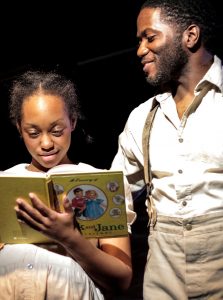Nobel Laureate’s Bluest Eye Is Lyrical to a Fault

Lorene Chesley, Cashae Monya, Melissa Coleman-Reed, Warner Miller, and Marshel Adams
Photos by Daren Scott
Toni Morrison’ The Bluest Eye sneaks up on you. Lyrical and poetic almost to a fault, it lulls you into a sense that you are experiencing not much that is out of the ordinary and then bit by bit horrifies without one bit of modulation of tone.
Moxie Theatre and Mo’olelo Performing Arts have not only found common ground but have bonded at the hip in this co-production, playing through March 3. Moxie focuses on women as authors and characters and also is coming off a 2012 season that was strong enough to win the San Diego Theatre Critics Circle’s Don Braunagel Award for achievement by a small theatre company. Mo’olelo focuses on producing high-quality work about diverse communities, as well as on educational outreach.
Together, they make a potent combination, resulting in a vibrant telling of a story by a living Nobel Laureate.
Set at the end of the Great Depression in Lorain, Ohio, her home town, The Bluest Eye is Ms. Morrison’s first novel. It recounts a coming-of-age tale set amongst the social and economic pressures of a Rust Belt mill town.
Pecola Breedlove (Cashae Monya) is eleven and a dreamer. Her mother (Melissa Coleman-Reed) works as a maid in a white household. Her father, Cholly (Warner Miller), has been incarcerated much of his adult life. Sometimes, Pecola helps her mother with her work, but sometimes she plays with her friends, Frieda (Marshel Adams) and Claudia (Lorene Chesley). Frieda and Claudia’s parents (Kimberly King and Abner Genece) are sometimes about, but the girls play on their own a good deal of the time.
Pecola is not pretty, and she is self-conscious about her looks. She is surrounded by images of white children as the ideal, from Shirley Temple as a child movie star, to the Dick and Jane books she reads to the white, blue-eyed doll that is her treasured toy. The three playmates feel intimidated by a pretty, light-skinned girl at their school (Chelsea Diggs-Smith), who clearly comes from a more well-to-do family. Even though they live in the integrated north, the girls are very aware of their social and economic status in Lorain.
Dreaming that blue eyes will bring her a better life, Pecola eventually seeks out Soaphead Church (Mr. Genece), an immigrant who manages to make a living by interpreting dreams. Much like the Wizard of Oz (not coincidentally, a popular film of the era), Soaphead convinces Pecola that her eyes have turned blue, even if no one else notices. There is often a price to pay for naiveté, though, and Pecola pays that price horrifically.
Playwright Lydia Diamond (Stick Fly) has adapted Ms. Morrison’s novel for the stage. She has done so in the style of chamber theatre, with various characters serving as narrator as well as engaging in dialogue. Ms. Diamond has an ear for language and how it’s spoken, and she provides enough of it to let the plot unfold gradually and without urgency. Several of the secondary characters are archetypes, though, and while Ms. Diamond makes them charming (mostly) they remain pretty unidimensional (Ms. Diggs-Smith as the light-skinned Maureen is a notable exception). The leisurely pace may well foretell squirming when the cast performs for student audiences. [php snippet=1]
Moxie has provided both the space, at its Rolando home, and much of the creative talent for the production. Heading the creative team is director Delicia Turner Sonnenberg, Moxie’s artistic head. Finely detailed ensemble work is Ms. Sonnenberg’s forte, and The Bluest Eye is no exception to that rule, particularly in casting Ms. Monya, Ms. Adams, and Ms. Chesley, adult actors who prove to be utterly convincing as children. The production is helped by a clever and utilitarian scenic design (by Brian Redfern), complimented by the soft colors of Luke Olson’s lighting. Fight director extraordinaire George Yé worked his magic as well as designed the sound, and the rest of the technical elements were executed in a highly professional manner.
The Bluest Eye may rile audience emotions but it is unlikely to rouse. Rather, its viewers may well appreciate the artistry of author, cast and creative team more than the story itself.
[box] Performs at Moxie Theatre on February 9, 14, 15, 16, 21, 22, 23, 28, March 1, 2, at 8pm, February 10, 17, and March 3 at 2pm. High School matinees are scheduled for 10am on February 13, 20, and 27. Tickets ($22 – $30) are available on the Moxie Theatre website (below) or by calling 858-598-7620. The theatre is located on El Cajon Blvd in Rolando; use either the College Avenue of 70th Street exits from Interstate 8. Free parking is available.
DOWNLOAD CAST AND CREDITS[/box]

In addition to reviewing theatre for San Diego Story, Bill also reviews for TalkinBroadway.com. He is a member of the San Diego Theatre Critics Circle and the American Theatre Critics Association. Bill is an emeritus professor in the School of Journalism and Media Studies at San Diego State University.




